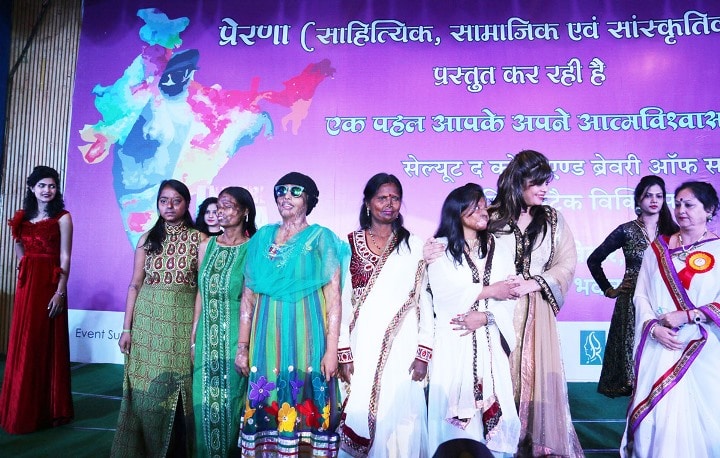Life
Stop The Band

INDIA050 We are consumed every time an Indian gets however passing a recognition abroad. In fashion circles, the commencement of New York Fashion Week (NYFW) snowballs a flurry of activities across the globe. With designers, stylists, reporters, merchandi
We are consumed every time an Indian gets however passing a recognition abroad.
In fashion circles, the commencement of New York Fashion Week (NYFW) snowballs a flurry of activities across the globe. With designers, stylists, reporters, merchandisers and models world over taking tab of the designs on display on the runways, there is a media frenzy to report every pleated nuance and embroidered detail.
But this time around, when fashion week in New York, opened to packed audiences last month, the pitch of the sub continental cheers from India seemed loudest. Indians were particularly proud of the fact that NYFW had a “strong” India presence. That India had a presence cannot be denied, as Reshma Qureshi, an acid attack survivor from India walked the coveted runway for Indian designer Archana Kochchar. FTL Moda, a fashion production company that is committed to challenge the stereotype of beauty in the industry, had invited Qureshi to be a part of the NYFW event.

Aishwarya Rai’s presence in Pink Panther was hyped by the media.While it is significant for a victim of such a brutal attack to get a platform anywhere to rise above her situation, the fact that it was New York that gave her that recognition got Indians to particularly relish the moment.
It could have been an equally, if not more important, moment if Qureshi were to walk any other Indian runway or make an appearance at an event in her home country, but somehow the idea that the West has chosen to recognize India yet again managed to steal the spotlight. The headlines didn’t stop at that. We were in a mood to seize the moment some more. Sunny Leone, a Canadian actress of Indian origin now working in Bollywood, who also walked the ramp for the same designer was equally feted by Indians.
While many skeptics were left debating whether Qureshi’s appearance was just a publicity stunt or something that might indeed help acid attack victims in India, what actually stood out was that Indians, again, were more interested in celebrating the hint of another nod from the Western world.
In an inexplicable paradox, despite the fact that most Indian designers make their money catering to their homegrown customers and the biggest market for Indian designers continues to be India, every year, the headlines tease out the slightest Indian connection on the Western ramp in an extraordinarily celebratory way.
Ad filmmaker and social commentator Prahlad Kakkar says: “The colonial hangover hasn’t gone away from our collective mentalities. Interestingly, even though somebody who’s doing a mediocre work, if he’s applauded by Western media, we would all go in a collective echo to claim the genius, we just discovered.”

Amitabh Bachchan’s guest appearance in The Great Gatsby was touted as a grest accomplishment for India’s greatest living actor.Fashion is by no means exclusive in this collective psyche. We are consumed every time an Indian gets however cursory recognition abroad. It’s only now that Priyanka Chopra and Deepika Padukone are actually claiming the real spotlight in Hollywood. However, for decades we have been celebrating that illusionary Bollywood presence in the Western world. From Aishwarya Rai’s Pink Panther to Amitabh Bachchan’s The Great Gatsby, what we discovered after prolonged hype was something close to a guest appearance.
Kakkar also points out: “While today Priyanka may be valid example to show our presence on American television, even before that Kunal Nayyar and Mindy Kaling were almost forcibly celebrated as Indians making it big.”
He notes: “These actors grew up in America, developed an American way of living, hence it’s wrong to equate them as Indian achievers. When someone who spent their years in India is able to take that leap and make a mark in a new territory, only then we can hail them as someone championing the Indian cause.”
Likewise, many Indians back home celebrated the rise of Bobby Jindal as the big Indian homecoming in American mainstream politics. The fact that Jindal himself felt little in common with the country of his origin or his faith of birth, was a bitter pill, which most were willing to swallow.

Manish Arora’s acclaimed Butterfly Dress is madef from 1500 plastic, hand emroidered butterflies that glow under UV lightIn global fashion circles, the achievements of Indians have been few and far between. Aside from Manish Arora, no other Indian name has helmed any global brand or acquired major recognition. Yet, the sari like kimono, which has often served as a canvas for may western designers, has been variously hailed by Indian media as our contribution to Western fashion. Sadly, it has often remained the only talking point for our presence in Western fashion.
But every time Michelle Obama wears a Naeem Khan or Bibhu Mahapatra, Indians are quick to snatch the headlines about the first lady and her love for Indian designers. The fact that both these internationally acclaimed designers studied and now live abroad doesn’t matter. Even more amusingly, often another big Asian name, Prabal Gurung, has been celebrated and talked up in the media on his Indian connection. That Gurung is a Nepalese who lived in India only a couple of years to study at National Institute of Fashion Technology and has worked in the United States ever since, has been conveniently glossed over.
So this year too, as Indian scribes are busy writing reams about Qureshi and her grit that took her all the way to New York, what we really need to ask ourselves is what we are doing closer at home to ensure that girls are protected against such tragedies.
Acid attack victims during a fashion show organized ahead of International Women’s Day in Bhopal, in March 2016, attracted little media attention.
